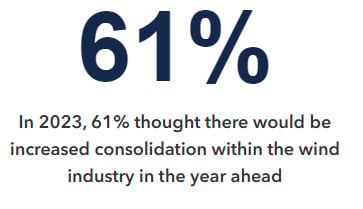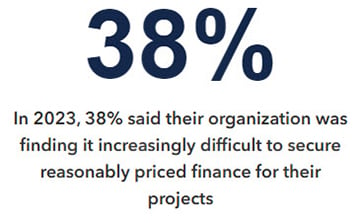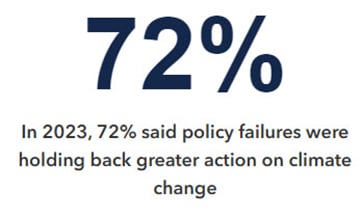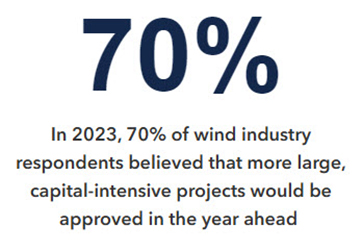We are comparing our Global Offshore Wind Segment Leader's top five predictions for what lies ahead with the results of DNV's external Industry Insights research:
1. There will be a 'stabilization' of raw material prices
 We're already seeing a significant stabilization in raw material prices and a notable reduction in the component bottlenecks we saw in the aftermath of the COVID-19 pandemic. The initial price surges triggered by the onset of the Ukraine war have also now subsided. Throughout 2022 and 2023, original equipment manufacturers (OEMs) successfully implemented price increases, yielding positive outcomes evident in their reported financial results. While this favourable trend is particularly pronounced for key players like Vestas, it's anticipated that other industry participants will eventually experience similar benefits. However, it's worth noting that there's an expectation of some consolidation within the sector as this positive shift continues to unfold.
We're already seeing a significant stabilization in raw material prices and a notable reduction in the component bottlenecks we saw in the aftermath of the COVID-19 pandemic. The initial price surges triggered by the onset of the Ukraine war have also now subsided. Throughout 2022 and 2023, original equipment manufacturers (OEMs) successfully implemented price increases, yielding positive outcomes evident in their reported financial results. While this favourable trend is particularly pronounced for key players like Vestas, it's anticipated that other industry participants will eventually experience similar benefits. However, it's worth noting that there's an expectation of some consolidation within the sector as this positive shift continues to unfold.
2. Interest rates will fall

Our second prediction, and one with potentially greater significance, is that interest rates, seem to have peaked and have started to come down. This bodes well for the economic feasibility of offshore wind projects, which, given their extensive lead times, can be vulnerable to elevated interest rates and discounting rates. Looking ahead to the current year, it appears that interest rates will continue to fall throughout 2024, which will have a positive influence on the investment appeal of wind technology—especially when considering the additional impact of prediction number three...
3. Governments and regulators will take action
 There's a noticeable proactive stance from governments and regulators in re-calibrating the regulatory frameworks crucial to offshore wind, including for subsidies, permitting, and grid investments. Notable actions include the Inflation Reduction Act in the USA and various initiatives from the EU Commission and its member states. At the end of 2023, the UK government expressed its intent to bolster the Contract for Difference (subsidy) for offshore wind, by 66%, compared to the earlier auction round 5 in the same year, which saw no bidders. The upcoming bidding round with these adjusted prices promises to be a captivating watch, potentially serving as a benchmark for subsidy re-calibrations in other markets.
There's a noticeable proactive stance from governments and regulators in re-calibrating the regulatory frameworks crucial to offshore wind, including for subsidies, permitting, and grid investments. Notable actions include the Inflation Reduction Act in the USA and various initiatives from the EU Commission and its member states. At the end of 2023, the UK government expressed its intent to bolster the Contract for Difference (subsidy) for offshore wind, by 66%, compared to the earlier auction round 5 in the same year, which saw no bidders. The upcoming bidding round with these adjusted prices promises to be a captivating watch, potentially serving as a benchmark for subsidy re-calibrations in other markets.
4. Investments will no longer be left to market whims
 Looking across the Atlantic, 2023 witnessed a series of setbacks, including the cancellations or delays of projects along the east coast of the USA— including Ocean Wind, Empire Wind, Park City Wind, and Commonwealth Wind. These substantial disruptions at an industry-wide scale, serve as a stark reminder to regulators that the landscape surrounding offshore wind has undergone significant shifts over the past two years. What may have been commercially viable back in 2021 is no longer feasible today. It's a poignant reminder that investments in energy generation are too crucial to be solely entrusted to the market's whims. Behind the scenes, industry players, investors, and governments are swiftly acknowledging this reality, with many actively engaged in the process of recalibrating prices, projects, and subsidies.
Looking across the Atlantic, 2023 witnessed a series of setbacks, including the cancellations or delays of projects along the east coast of the USA— including Ocean Wind, Empire Wind, Park City Wind, and Commonwealth Wind. These substantial disruptions at an industry-wide scale, serve as a stark reminder to regulators that the landscape surrounding offshore wind has undergone significant shifts over the past two years. What may have been commercially viable back in 2021 is no longer feasible today. It's a poignant reminder that investments in energy generation are too crucial to be solely entrusted to the market's whims. Behind the scenes, industry players, investors, and governments are swiftly acknowledging this reality, with many actively engaged in the process of recalibrating prices, projects, and subsidies.
5. Brace yourself for a year of sizeable projects
 2024 promises to be exceptionally busy year, marked by multiple big tenders. This heightened activity is not only a result of the new projects planned for this year but also due to the delayed projects inherited from 2023. These projects are now converging, creating a substantial pipeline for planned tenders in 2024. Brace yourself for a wave of sizable projects set to kick off, including the UK auction round 6 (10-14.5 GW), USA (10 GW), Denmark (8 GW), Germany (2.5-5.5 GW), Portugal and Spain (5 GW), Japan (4 GW), India (4 GW), Netherlands (4 GW), Taiwan (3 GW), South Korea (1.5 GW), and more. With even just half of this pipeline getting underway in 2024, we're in for a significant surge in offshore wind project development activities in the years ahead.
2024 promises to be exceptionally busy year, marked by multiple big tenders. This heightened activity is not only a result of the new projects planned for this year but also due to the delayed projects inherited from 2023. These projects are now converging, creating a substantial pipeline for planned tenders in 2024. Brace yourself for a wave of sizable projects set to kick off, including the UK auction round 6 (10-14.5 GW), USA (10 GW), Denmark (8 GW), Germany (2.5-5.5 GW), Portugal and Spain (5 GW), Japan (4 GW), India (4 GW), Netherlands (4 GW), Taiwan (3 GW), South Korea (1.5 GW), and more. With even just half of this pipeline getting underway in 2024, we're in for a significant surge in offshore wind project development activities in the years ahead.
2024 is gearing up to be a pivotal year for tenders, with a keen focus on financial project sustainability playing an important role. While not every tender may come to fruition this year, there's optimism that they will gain momentum in 2025. It's crucial for the pipeline to solidify quickly, not only for efficient supply chain planning but also politically, as it aligns with the 2030 offshore wind goals. However, time is of the essence, and the clock is ticking. Given the extended lead times of offshore wind projects, many initiated this year may not generate power until 2032-34. Wind energy is needed for the security of our power supply, particularly in Europe, Japan, Taiwan, and elsewhere, and in our efforts to mitigate climate change globally.
2024 looks set to be a frenzy of bid preparations from developers, governments, and investors, navigating the intricate web of macro-economic and geo-political risks in the current landscape. Delays and indecision are not an option; societies need a stable, environmentally sustainable energy supply. As an industry we all need to roll up our sleeves and get to work!

 We're already seeing a significant stabilization in raw material prices and a notable reduction in the component bottlenecks we saw in the aftermath of the COVID-19 pandemic. The initial price surges triggered by the onset of the Ukraine war have also now subsided. Throughout 2022 and 2023, original equipment manufacturers (OEMs) successfully implemented price increases, yielding positive outcomes evident in their reported financial results. While this favourable trend is particularly pronounced for key players like Vestas, it's anticipated that other industry participants will eventually experience similar benefits. However, it's worth noting that there's an expectation of some consolidation within the sector as this positive shift continues to unfold.
We're already seeing a significant stabilization in raw material prices and a notable reduction in the component bottlenecks we saw in the aftermath of the COVID-19 pandemic. The initial price surges triggered by the onset of the Ukraine war have also now subsided. Throughout 2022 and 2023, original equipment manufacturers (OEMs) successfully implemented price increases, yielding positive outcomes evident in their reported financial results. While this favourable trend is particularly pronounced for key players like Vestas, it's anticipated that other industry participants will eventually experience similar benefits. However, it's worth noting that there's an expectation of some consolidation within the sector as this positive shift continues to unfold.
 There's a noticeable proactive stance from governments and regulators in re-calibrating the regulatory frameworks crucial to offshore wind, including for subsidies, permitting, and grid investments. Notable actions include the Inflation Reduction Act in the USA and various initiatives from the EU Commission and its member states. At the end of 2023, the UK government expressed its intent to bolster the Contract for Difference (subsidy) for offshore wind, by 66%, compared to the earlier auction round 5 in the same year, which saw no bidders. The upcoming bidding round with these adjusted prices promises to be a captivating watch, potentially serving as a benchmark for subsidy re-calibrations in other markets.
There's a noticeable proactive stance from governments and regulators in re-calibrating the regulatory frameworks crucial to offshore wind, including for subsidies, permitting, and grid investments. Notable actions include the Inflation Reduction Act in the USA and various initiatives from the EU Commission and its member states. At the end of 2023, the UK government expressed its intent to bolster the Contract for Difference (subsidy) for offshore wind, by 66%, compared to the earlier auction round 5 in the same year, which saw no bidders. The upcoming bidding round with these adjusted prices promises to be a captivating watch, potentially serving as a benchmark for subsidy re-calibrations in other markets. Looking across the Atlantic, 2023 witnessed a series of setbacks, including the cancellations or delays of projects along the east coast of the USA— including Ocean Wind, Empire Wind, Park City Wind, and Commonwealth Wind. These substantial disruptions at an industry-wide scale, serve as a stark reminder to regulators that the landscape surrounding offshore wind has undergone significant shifts over the past two years. What may have been commercially viable back in 2021 is no longer feasible today. It's a poignant reminder that investments in energy generation are too crucial to be solely entrusted to the market's whims. Behind the scenes, industry players, investors, and governments are swiftly acknowledging this reality, with many actively engaged in the process of recalibrating prices, projects, and subsidies.
Looking across the Atlantic, 2023 witnessed a series of setbacks, including the cancellations or delays of projects along the east coast of the USA— including Ocean Wind, Empire Wind, Park City Wind, and Commonwealth Wind. These substantial disruptions at an industry-wide scale, serve as a stark reminder to regulators that the landscape surrounding offshore wind has undergone significant shifts over the past two years. What may have been commercially viable back in 2021 is no longer feasible today. It's a poignant reminder that investments in energy generation are too crucial to be solely entrusted to the market's whims. Behind the scenes, industry players, investors, and governments are swiftly acknowledging this reality, with many actively engaged in the process of recalibrating prices, projects, and subsidies. 2024 promises to be exceptionally busy year, marked by multiple big tenders. This heightened activity is not only a result of the new projects planned for this year but also due to the delayed projects inherited from 2023. These projects are now converging, creating a substantial pipeline for planned tenders in 2024. Brace yourself for a wave of sizable projects set to kick off, including the UK auction round 6 (10-14.5 GW), USA (10 GW), Denmark (8 GW), Germany (2.5-5.5 GW), Portugal and Spain (5 GW), Japan (4 GW), India (4 GW), Netherlands (4 GW), Taiwan (3 GW), South Korea (1.5 GW), and more. With even just half of this pipeline getting underway in 2024, we're in for a significant surge in offshore wind project development activities in the years ahead.
2024 promises to be exceptionally busy year, marked by multiple big tenders. This heightened activity is not only a result of the new projects planned for this year but also due to the delayed projects inherited from 2023. These projects are now converging, creating a substantial pipeline for planned tenders in 2024. Brace yourself for a wave of sizable projects set to kick off, including the UK auction round 6 (10-14.5 GW), USA (10 GW), Denmark (8 GW), Germany (2.5-5.5 GW), Portugal and Spain (5 GW), Japan (4 GW), India (4 GW), Netherlands (4 GW), Taiwan (3 GW), South Korea (1.5 GW), and more. With even just half of this pipeline getting underway in 2024, we're in for a significant surge in offshore wind project development activities in the years ahead.